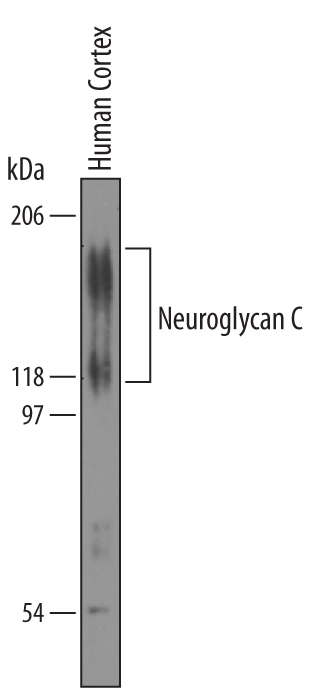Human Neuroglycan C/CSPG5 Antibody
R&D Systems, part of Bio-Techne | Catalog # AF5685

Key Product Details
Species Reactivity
Human
Applications
Immunohistochemistry, Western Blot
Label
Unconjugated
Antibody Source
Polyclonal Sheep IgG
Product Specifications
Immunogen
Chinese hamster ovary cell line CHO-derived recombinant human Neuroglycan C/CSPG5
Val31-Gln420
Accession # AAQ04776
Val31-Gln420
Accession # AAQ04776
Specificity
Detects human Neuroglycan C/CSPG5 in direct ELISAs and Western blots. In direct ELISAs, approximately 50% cross‑reactivity with recombinant mouse Neuroglycan C is observed.
Clonality
Polyclonal
Host
Sheep
Isotype
IgG
Scientific Data Images for Human Neuroglycan C/CSPG5 Antibody
Detection of Human Neuroglycan C/CSPG5 by Western Blot.
Western blot shows lysates of SH-SY5Y human neuroblastoma cell line. PVDF membrane was probed with 1 µg/mL of Sheep Anti-Human Neuroglycan C/CSPG5 Antigen Affinity-purified Polyclonal Antibody (Catalog # AF5685) followed by HRP-conjugated Anti-Sheep IgG Secondary Antibody (Catalog # HAF016). Specific bands were detected for Neuroglycan C/CSPG5 at approximately 120 and 150 kDa (as indicated). This experiment was conducted under reducing conditions and using Immunoblot Buffer Group 8.Applications for Human Neuroglycan C/CSPG5 Antibody
Application
Recommended Usage
Immunohistochemistry
5-15 µg/mL
Sample: Perfusion fixed frozen sections of mouse brain (cerebellum)
Sample: Perfusion fixed frozen sections of mouse brain (cerebellum)
Western Blot
1 µg/mL
Sample: SH-SY5Y human neuroblastoma cell line
Sample: SH-SY5Y human neuroblastoma cell line
Reviewed Applications
Read 1 review rated 5 using AF5685 in the following applications:
Formulation, Preparation, and Storage
Purification
Antigen Affinity-purified
Reconstitution
Reconstitute at 0.2 mg/mL in sterile PBS. For liquid material, refer to CoA for concentration.
Formulation
Lyophilized from a 0.2 μm filtered solution in PBS with Trehalose. *Small pack size (SP) is supplied either lyophilized or as a 0.2 µm filtered solution in PBS.
Shipping
Lyophilized product is shipped at ambient temperature. Liquid small pack size (-SP) is shipped with polar packs. Upon receipt, store immediately at the temperature recommended below.
Stability & Storage
Use a manual defrost freezer and avoid repeated freeze-thaw cycles.
- 12 months from date of receipt, -20 to -70 °C as supplied.
- 1 month, 2 to 8 °C under sterile conditions after reconstitution.
- 6 months, -20 to -70 °C under sterile conditions after reconstitution.
Background: Neuroglycan C/CSPG5
References
- Kinugasa, Y. et al. (2004) Biochem. Biophys. Res. Commun 321:1045.
- Yasuda, Y. et al. (1998) Neurosci. Res. 32:313.
- Ichihara-Tanaka, K. et al. (2006) J. Biol. Chem. 281:30857.
- Aono, S. et al. (2004) J. Biol. Chem. 279:46536.
- Shuo, T. et al. (2007) J. Neurochem. 102:1561.
- Aono, S. et al. (2006) J. Neurosci. Res.83:110.
- Nakanishi, K. et al. (2006) J. Biol. Chem. 281:24970.
Alternate Names
CALEB, CSPG5, NGC
Gene Symbol
CSPG5
UniProt
Additional Neuroglycan C/CSPG5 Products
Product Documents for Human Neuroglycan C/CSPG5 Antibody
Product Specific Notices for Human Neuroglycan C/CSPG5 Antibody
For research use only
